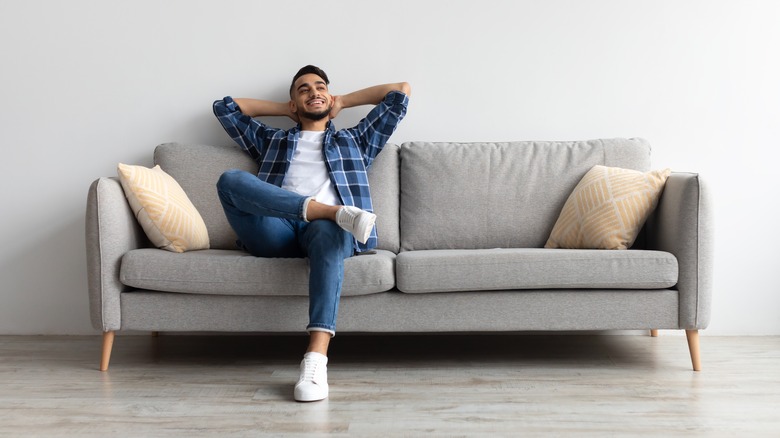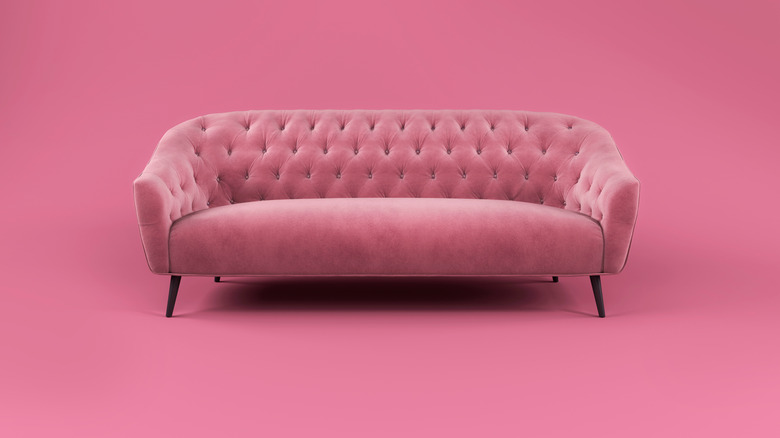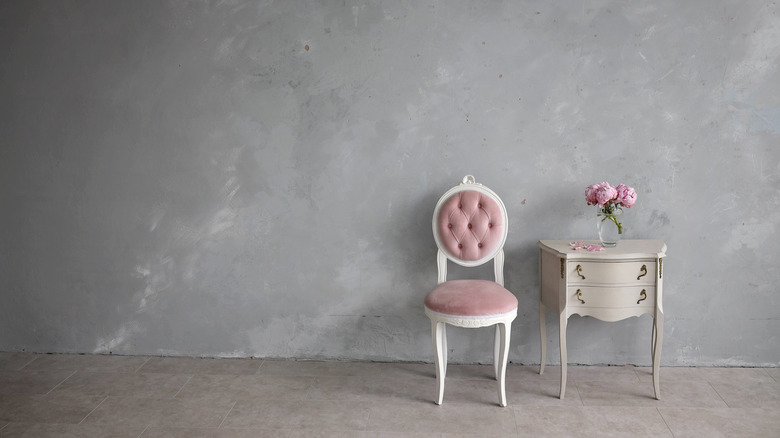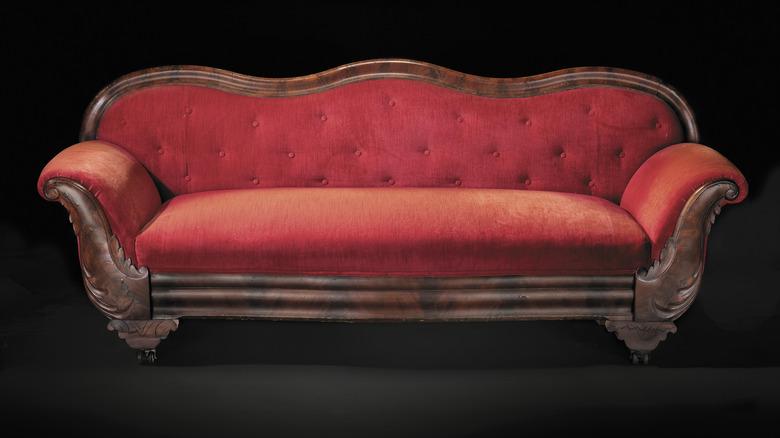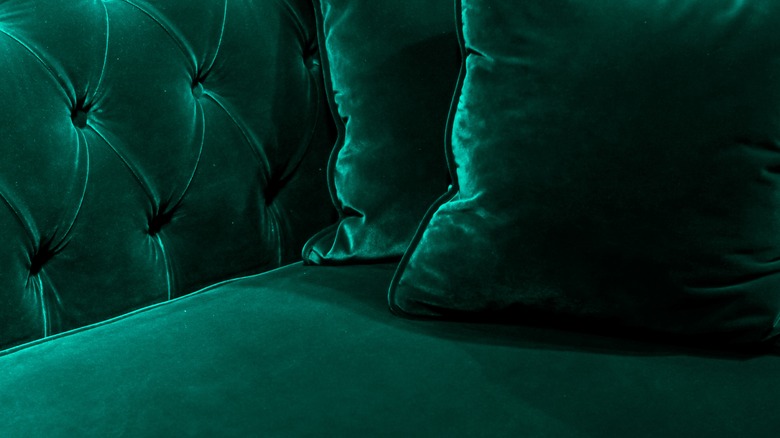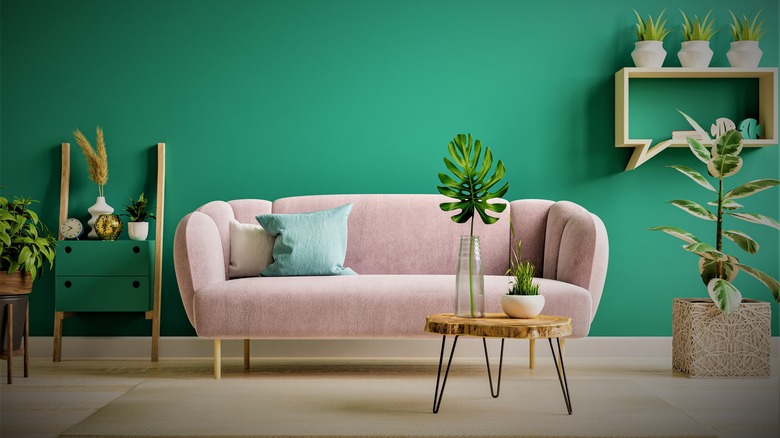5 Tips For Making Your Old Couch Look New Again
Refreshing an old couch is a great skill to have in your arsenal. Couches are an expensive purchase, and throwing away (or donating) a sofa and replacing it can often be a lengthy and physically draining process.
Instead, taking steps to refresh the look and feel of your current couch can make for a brand new aesthetic in the home while taking advantage of a piece of furniture that you already own. This can save you a lot of money, time, and energy, and is a great way to spend time with loved ones working on projects that promote self-sufficiency and ingenuity. Becoming more self-sufficient is something that many people are looking for these days, and DIY projects that breathe new life into old items throughout the home is at the top of many people's lists (via Graceful Little Honey Bee).
With these five key tips, reinvigorating an old couch can be easy and fun, leaving you with a cost-effective and beautiful end product that will continue to provide value to your home.
Remove skirting to reveal the couch's legs
Many older couches made use of skirting material that dropped the overall footprint right down to ground level. This is an outdated style trend that can make your sofa look much older than it really is. By removing the skirting from your couch, you can provide a sense of elevation to the furniture and create a transformational new look and feel to this essential piece. You can accomplish this task either by cutting away the skirting material that reaches down toward the floor, or by simply stapling the skirting up underneath the couch for a quick change that doesn't require a lot of technical skill or work with sharp blades (via This American House).
Creating this gap between the sofa and the floor imparts a modern look with little overall effort. Chairs and couches that make use of skirting almost always incorporate legs in the design (instead of resting directly on the floor). These elements can be showed off for a luxurious new addition without having to make a trip to the store or splurging on a new couch.
Paint a poor upholstery color to add vibrancy
Painting an old couch might sound like an exercise in madness, but the truth is that with a can of paint and a specialized fabric textile medium addition, changing the color of your couch's upholstery is actually very simple (via Happiness is Homemade). Not only that, painting the upholstery can make for an unexpected and intensely valuable change in the visual aspects of the room.
It's a good idea to spend some quality time evaluating potential paint options before committing to the painting phase. Paint that's been applied to upholstery with this method will create a permanent stain effect, so it's best to decide on a paint color that you really love before beginning the work.
After you've selected a color that's perfect for the room and your couch, you'll want to clean the surface thoroughly. You don't need to eliminate ink stains and other issues because the color will wash right over these imperfections, but removing surface grease, debris, and other elements that will become stuck in the upholstery if painted over is crucial.
A foam brush is a great option for digging into the fabric of the couch cushions and across the entire stretch of the surface. Painting in uniform coats will provide a refreshed couch that's ready to add a new pop of color to any room.
Create custom tufted cushions for a luxurious aesthetic
Tufted couches are often associated with the height of luxury. Homeowners love the look of a tufted couch that matches these textures with leather and upholstery alike. As a result, tufted furniture tends to cost more than a standard, flat-backed couch. However, creating your own tufted effect is actually easier than you might think.
Livspace notes that tufted furniture not only looks great, but it also provides a much more comfortable sitting experience for those relaxing on the couch or chair. In order to create this lavish look and immensely comfortable feel, all you'll need is a needle and thread, and buttons of some kind to cap off each of the indentations across the surface.
All this process takes is a little patience and an understanding of sewing. Pulling your thread through the fabric of the couch will create a pull from the outward-facing front side. Going over the loop a few times secures the indentation in place, and then adding a button to the front completes the process. Rinse and repeat across the surface to create an even texture for a customized, tufted couch that packs in immense value and comfort without having to shell out for a new, luxury item.
Recreate the cushions with new covering options
Slipcovers are a common theme among homeowners looking to extract the extra mile out of their couches, chairs, pillows, and more. Any item that makes use of cushions can be refreshed with the introduction of newly purchased or sewn slipcovers. Indeed, making your own slipcovers can give you complete creative control over the project while slashing your budget down to the bare minimum (via The Shabby Creek Cottage).
Slipcovers are easy to use, and whether you know it or not, your couch probably already makes use of this type of outer covering. Simply replacing a tired outer fabric with something fresh and new can revitalize the look and feel of the couch in an instant. As well, with the use of new slipcovers on your couch, you can mix and match colors or styles for a unique take on the decorative process. Using the color wheel to select compatible shades is a great way to go about this customization effort; alternatively, you can use a combination of solid tones with stripes, dots, or even text-based covers for maximum personality.
Restuff sagging cushion segments for new volume and comfort
Lastly, one of the primary issues that homeowners face as their couches begin to get up there in years is the sagging of cushions, both in the seat and the backrest sections. Restuffing the cushions is a great way to reinvigorate the couch and bring it dramatically back to life (via Pulling Curls). For couches that see a lot of seating action but might not have the same staining issues that are common in households with small children (or clumsy adults), this approach might be the perfect solution.
Sagging happens naturally as the stuffing is compressed through usage and aging. Removing old stuffing and replacing it with a new foam filler will plump up the cushions back to their original state, giving you a brand new feeling of comfort when you sit down on the couch. Another version of this approach is to restuff the seating space and replace the backrest components with oversized pillows with fresh, new slipcovers, blending multiple refresh options together for maximum comfort and visual appeal.
